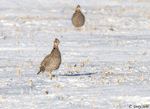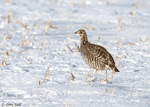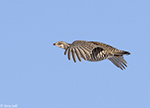| Length: 18 inches | Wingspan: 28 inches | Seasonality: All Seasons |
| ID Keys: Body size and shape, brown overall with heavy light barring, short rounded dark tail, yellow eye combs. | ||
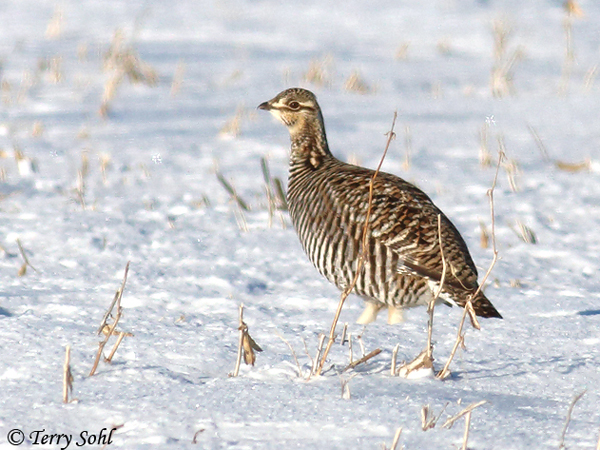 The
Greater Prairie Chicken perform their spectacular booming displays every spring
on traditional sites, called leks. Males have inflatable sacs on the sides of
their neck which inflate during courting displays, and also have long feathers
which are raised while displaying. Greater Prairie Chickens are much reduced in
range and in numbers due to the loss of native tall-grass prairies. A
former subspecies, the "Heath Hen" was once found along the East Coast, but the
last ones were extirpated on Martha's Vineyard by the early 1930s. Another
subspecies, "Atwater's Prairie Chicken" is found near coastal regions in Texas
and is in serious danger of extinction. In South Dakota, however, they are
relatively common in the central part of the state, so much so that hunting
seasons are allowed for Greater Prairie Chickens.
The
Greater Prairie Chicken perform their spectacular booming displays every spring
on traditional sites, called leks. Males have inflatable sacs on the sides of
their neck which inflate during courting displays, and also have long feathers
which are raised while displaying. Greater Prairie Chickens are much reduced in
range and in numbers due to the loss of native tall-grass prairies. A
former subspecies, the "Heath Hen" was once found along the East Coast, but the
last ones were extirpated on Martha's Vineyard by the early 1930s. Another
subspecies, "Atwater's Prairie Chicken" is found near coastal regions in Texas
and is in serious danger of extinction. In South Dakota, however, they are
relatively common in the central part of the state, so much so that hunting
seasons are allowed for Greater Prairie Chickens.
Habitat:
Requires relatively undisturbed prairie, originally living on natural tallgrass prairie. They can tolerate a small amount of agricultural land interspersed with prairie, but generally become less and less numerous as the percentage of agricultural land increases.
Diet:
Primarily feeds on leaves, seeds, berries, and waste grain in the winter, as well as acorns where available. In the summer, these items are augmented by insects, especially when they are breeding and feeding young.
Behavior:
Forages most often near dawn and dusk, foraging on the ground most of the time, but also up in trees and shrubs.
Nesting:
May and June breeding in South Dakota, with lek displays occurring earlier. The nest itself is a simple depression on the ground, lined with grasses, feathers, and sometimes dead leaves or other vegetative material. The female lays between 6 and 15 eggs, and she alone incubates them. The young hatch after about 24 days.
Song:
Long, low hooting from male in display. Both males and females also having clucking sounds.
- Click here to hear the display calls of a male Greater Prairie Chicken1
- Click here to hear multiple display Greater Prairie Chickens on a lek2
Migration:
Generally a permanent resident, although individuals may move around within the same general area.
Interactive eBird Map:
Click here to access an interactive eBird map of Greater Prairie Chicken sightings
Similar Species:
- Sharp-tailed Grouse. The most obvious difference between a Greater Prairei Chicken and a Sharp-tailed Grouse is the plumage on the underside of the body. Sharp-tailed Grouse have a series of chevron-shaped posts, while Greater Prairie Chickens have a horizontal barring. As the namesake implies, Sharp-tailed Grouse also have a very differently shaped tail, tapering to a point (very obvious if seen well in flight). In comparison, the tail of a Greater Prairie Chicken is more squared off and blunt. See the species comparison chart for additional tips on differentiating between Greater Prairie Chickens and Sharp-tailed Grouse.
- Lesser Prairie-Chicken also very similar, but the two species do not overlap in geographic range, other than a very small part of northwestern Kansas. Within that range, there are hybrids of the two species that are found.
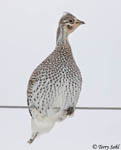 |
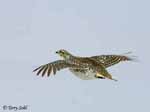 |
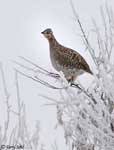 |
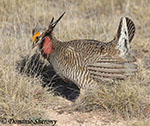 |
| Sharp-tailed Grouse | Sharp-tailed Grouse | Sharp-tailed Grouse | Lesser Prairie Chicken |
Status:
The now Atlantic Coast race (the Heath Hen) is now extinct. Other races such as the Texas Coast race (Attwater's) is seriously endangered. Extirpated locally elsewhere, they are greatly reduced in number and in range from their historical numbers, with estimates that they have declined by more than 90% in the last four decades. Numbers continue to decline as grassland habitats are lost to human uses. They are still common in parts of Kansas, Nebraska, and South Dakota, but given the overall threats to the species, the IUCN classifies the Greater Prairie Chicken as a "vulnerable" species.
Further Information:
- Patuxent Bird Identification InfoCenter, Greater Prairie Chicken
- Audubon Guide - Greater Prairie Chicken
- WhatBird - Greater Prairie Chicken
Photo Information:
December 27th, 2016 - Fort Pierre National Grasslands, South Dakota - Terry Sohl
Audio File Credits:
- 1Ross Gallardy. Recorded in Yuma County, Colorado on April 12th, 2019. Original recording and information available from xeno-canto.
- 2Andrew Spencer. Recorded in Yuma County, Colorado on May 1st, 2011. Original recording and information available from xeno-canto.
| Click on the map below for a higher-resolution view |
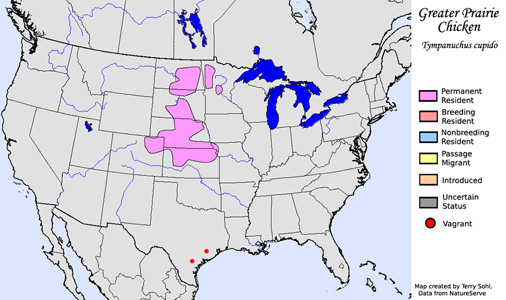 |
| South Dakota Status: Uncommon permanent resident in the central part of the state. |
Additional Greater Prairie Chicken Photos
